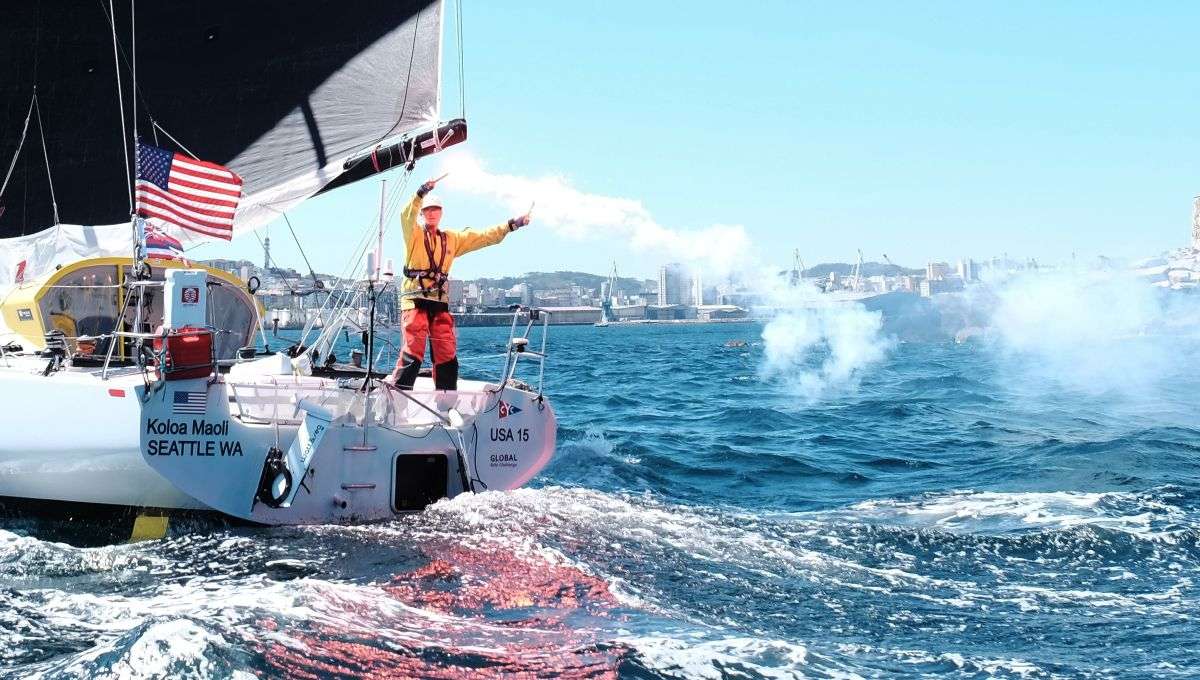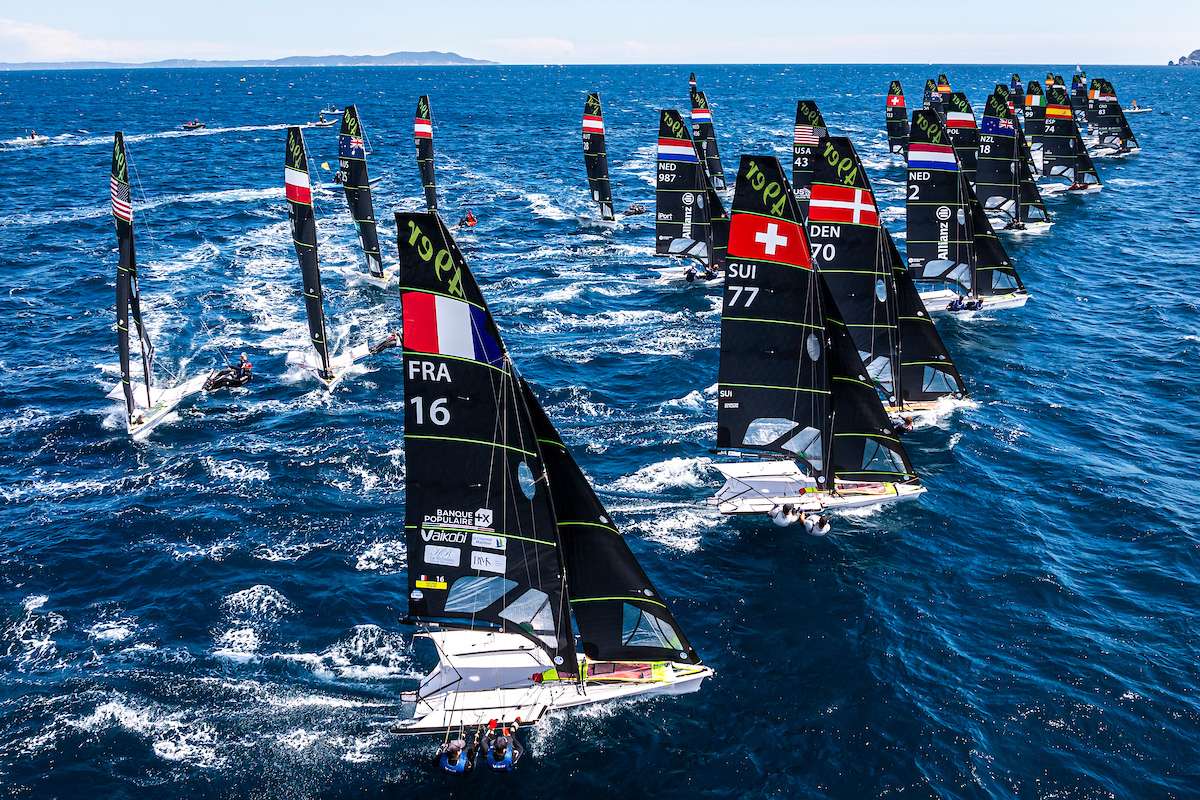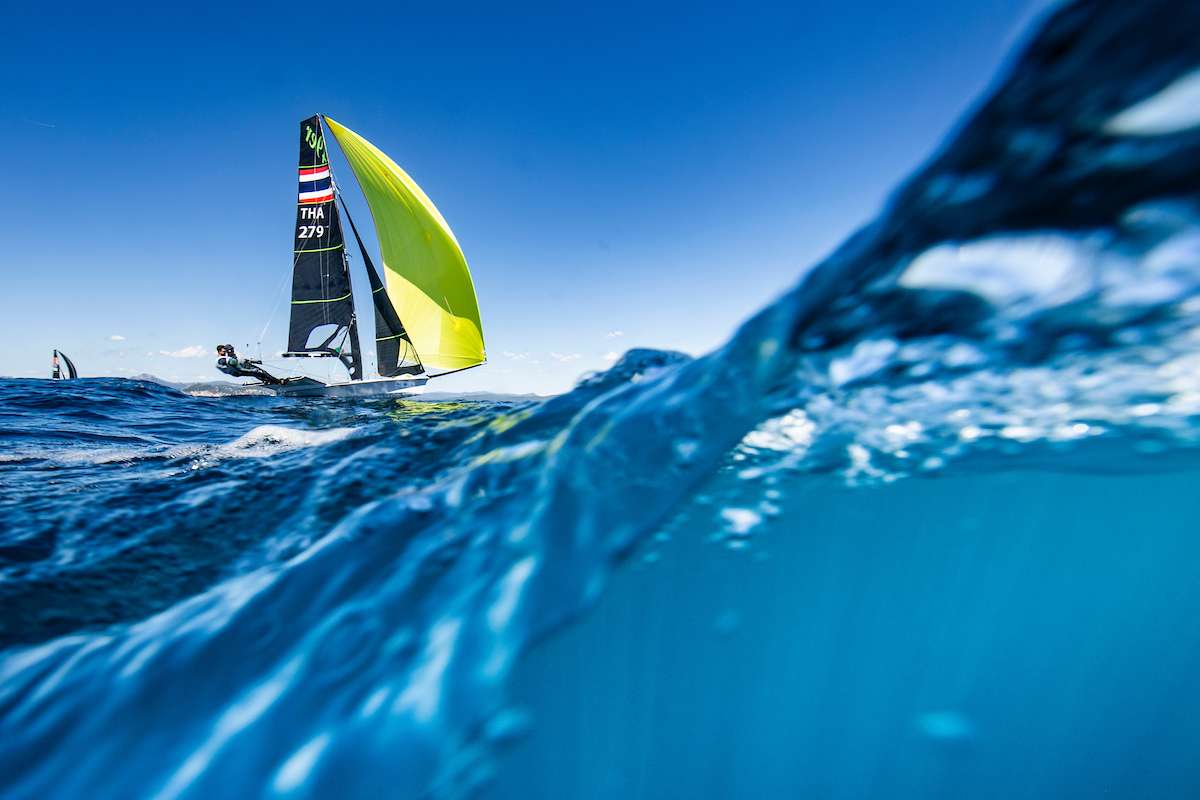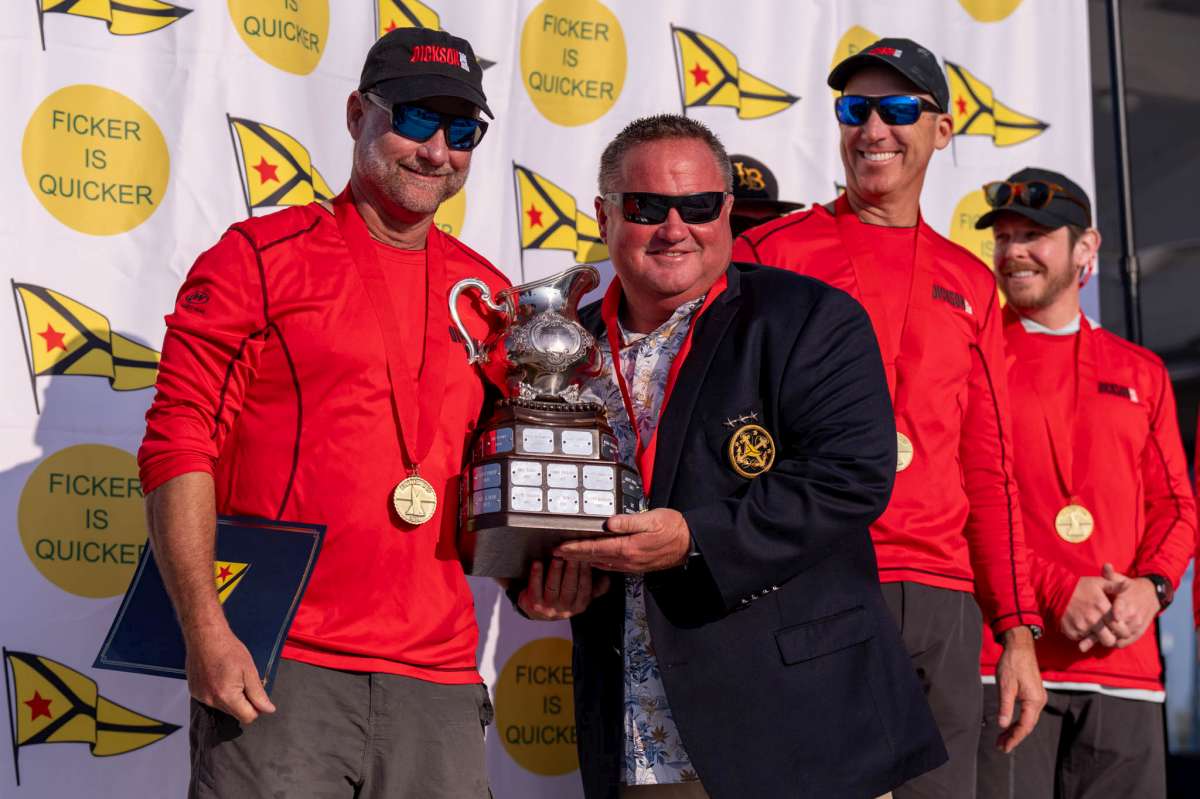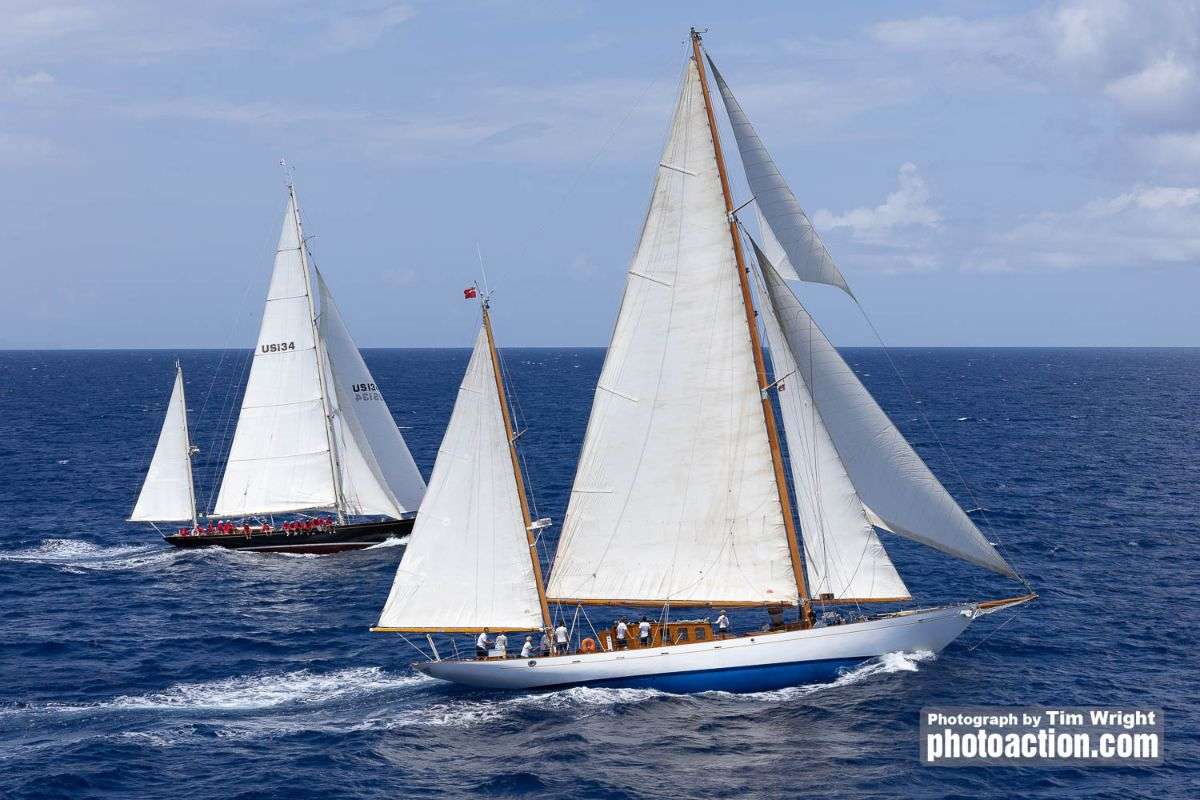That splinter of an idea: Sail to Lord Howe Island, had lodged there in my psyche many years, not festering but absolutely insistent. So, with the best (and worst) laid plans of mice, men and whoever else cares to dare, the day had come.
After a meticulous ten minutes of preparation and weather scanning, we were away. Two days of steady nor’-easter on the port beam should fetch Lord Howe to my anchor.
Contemplative, high tide ghosting across the sandflats on a zephyr, pilot on, watching the startled marine life scatter. At four knots we are no risk to them and we watch it all. Now how does a green turtle the size of a coffee table instantly accelerate that bulk to such high speed? They must be very powerful otherwise there is a secret to the shape I cannot see.
A dugong that has obviously seen it all looks over nonchalantly and asks “do you mind? Trying to get some grass here.”
Brisbane thankfully dropping astern, all that bitumen and glass creating enough convection to form a bronze stationary cloud. Air? No, something else. Always the background rumble, even from this distance. The sound of a dark, satanic mill at work and humans are the grist.
Trying to move through a forest of green, amber and the hell of an eternal red. Tacking through the barrier of shoal sandbanks on a falling tide at South Passage is a small trimaran’s forte. Polaroid sailing, I love it.
Gaining the deep, the heat is blasted away. Here is air, breeze, a clean blue ocean and a waypoint 400 nautical miles to the southeast. Brisbane no longer exists in that delicious way that a sailboat can absolve any awkward reality. If this is not freedom then it is as close as I will ever get.
Clear of Point Lookout and picked up by a vivid silky blue current streaming to the south, a river within an ocean. How wide will this river be? Where will its east margin lie?
It is amazing how long you can sail and not see a particular marine creature, then suddenly they are everywhere: manta rays, flying graceful vertical loops in this seemingly edible blue, sifting out the plankton. They always strike me as being noble creatures, wise, aloof and completely indifferent to humanity.
Little tri Frogi loves the sweet current. An effortless eleven knots speed over the ground with very little drive in the sails. Imagine this all the way to LHI. If you spend enough years looking at the surface of the ocean, you will begin to notice things. Signposts everywhere. Water colour, wave shapes. Over there for instance, a sharp little wind chop on top of the waves, standing up more than it should against a light nor-easter, spells the end of the free lunch ride on the blue highway. No matter, I have logged forty miles in no time.
We must continue to sail at eleven knots through the water to get eight over the ground. Languid cruise becomes less so and modern instruments confirm the uneasy suspicion. The boat must be kept up, now we need sailpower. It takes a leap of faith for a solo sailor, laying in the bunk, listening. Full main and asymmetrical powering against a contrary sea as the sun boils down into the ocean, nightfall.
It sounds at times as if there is a Tasmanian axeman out there on the weather arma doing his thing at The Royal Easter Show. I don my chainsaw earmuffs and scoff a tot of rum in such circumstance. Noise is a large component of fatigue, I need to take the edge off.
Faith yes, that the breeze is stable in strength and direction, the pilot will chirp away faithfully without a glitch, the dynamics of the hulls and boards will continue to talk to each other harmoniously. Everything is cleated back there in the cockpit, but getting there a little too late is … much too late.
So one develops a system of awareness and beliefs and assigns a solidity to that reality, which may or may not be warranted. What sailor ever cast his soul upon the sea without a storehouse of faith and, possibly, a bottle of rum.
Rock group America sang “the ocean is a desert with its life underground …” and when
you are fatigued it can seem so. But, in reality, the sea is still a vibrant thriving ecosystem despite man’s relentless efforts of wastage and extermination.
Always the flocks of flying fish launching away to escape the sailboat suddenly bearing upon them. The flying fish plays at the interface of sky and ocean. Everything in the sea wants to eat them and they do not know that this plywood monster feeds on wind. So the fish has become as adept at high speed evasion as a politician is to a direct question.
So here he is, very large all seeing eyes, graceful wide pectoral fins, the lower lobe of the caudal fin markedly elongated down into the water. When his glide is near its end, he only need lower that and vibrate to renew the glide.
Now, curiously, it beggars the question: how long does it take for a fish to evolve and adapt, changing physically to take flight? Answer: about as long as it took early hominids to be forced out of the trees due to climate change, scramble out of the Rift Valley, globally disperse themselves and eventually go on to build shopping malls and boats. About that long.
It had to happen of course, with these piscatorial aviators around in such numbers.
I was down below making a brew one night, the little tri gamely rollicking on, when ‘thwack’! A large flying fish flew in the companionway at speed, smacking me square in the head.
Slime and scales everywhere. These are very fishy fish, a strong odour. That night I was left with the inescapable sensation of having shampooed my hair with the contents of a can of Snappy Tom.
The breeze held all night, square to the beam, logging 8kn over the bottom, well on our way.
The dawn brought many visions of shearwaters crisscrossing the swells actively searching for food. These birds are my favourites. Nomads par excellence. They are aerodynamic perfection.
We try to set our sails to match their winged form of the perfect foil. They are an organic living airframe, using a cushion of air millimetres above a roiling sea. They are a marvel as they cover huge distances with nary a wingbeat, conserving energy to the ultimate efficiency, using the wave shape, compressing the air, banking away.
These birds are my heroes: “I might just pop over to the Arctic circle for summer, heard the fishing is good, see you back here next year.” I am watching these birds on their return journeys.
Their life is never easy and some years are very unkind. As the winds may be light they expend more energy, at such times you can see them, bobbing in their thousands, exhausted. Not a single wingbeat left. Failing to top up when you can with fuel on their trans-equatorial migration means you are not going to make it.
But, even especially in defeat, I admire them. They have given their all. The head pivots and the eye looks at you as you pass close. They are not concerned and have accepted their fate stoically. Just as a sailor may circumnavigate many times, the numbers are always tumbling and sometimes landing not so favourably.
I worry that as we wage war against our home planet, we are breaking up, dislocating vital fuel stops for these supreme navigators. We are sifting the food chain from the oceans, bottom to top. It may be that, to feed millions of indifferent cats, we are sacrificing a special life form.
Speaking of navigation, these birds return after dark to burrows where nesting young wait in hunger. Shearwaters are clumsy on the ground amongst the vegetation so the incentive is to target their particular burrow with unerring accuracy. So nightfall home they fly, orienting themseves to a starpath that will fetch to the exact spot.
Now, if you choose to anchor on that path and are not well lit, they will not deviate. They will strike you at speed and be much the worse for it.
Next question then: how long would it take for a bird that does not inhabit equatorial regions, discover that there is an abundant food source at the antipodes then evolve a complex navigational strategy, combine it with its breeding cycle … too much thinking for a solo sailor and forgive my divergence.
The little tri is dogging against the current, just like the shearwaters, she will not quit. The sea state is difficult, but the miles click down. Could it be better? Yes. Could it be worse? Bloody hell yes. Do not anger the gods with a single ungrateful thought.
The breeze is fair and steady as she goes. The sun is shining and oh the nights! Lay back and stare into that. That which is not blackness, that which is not empty, but a sparkling crystal myriad of all that is not earthbound. Possibilities and certainties beyond human conception. Right there. Just reach out and touch. Sigh!
The truth is, I am a little weary of solo sailing. I could point to the stars and say “just look and wonder”, but alone one’s thoughts echo round that citadel, the mind without distraction.
The mind can be the enemy: a source of greatness, folly and sadness. Best to keep it on a leash of sorts. I have heard all my jokes and I’ve never won an argument with myself yet. Knock knock! Who’s there? Just me, just me.
The massifs of Lord Howe erupt from the sea, proclaiming “we are here too”. Tantalising, there on the horizon in a fading breeze, trying to make the lagoon by nightfall. Using all tricks to keep boatspeed up. Another five degrees to port will power up the apparent breeze a little, but at what cost to the vector? Answer: sail the breeze you have now as best you can.
I was grateful to get in to the lagoon, rather than spending a night jangling around on an angular sea waiting for the morn. Grateful too, the island policeman Simon, left his dinner to guide me in to a stout mooring. Two and a half days, approximately 390nm at an average of about six and a half knots.
Hospitality was echoed all round the island. It is remarkable that you can sail for those few days from Sydney or Brisbane to find yourself totally removed from those fair cities atrocities. Here is an island culture, pedalling along at bicycle speed, spectacular scenery and people that are genuinely happy to be where they find themselves.
It being an offshore island and exposed to the capricious moods of the Tasman, all eyes are focussed on the weather. There is no mobile network and it is a long, sometimes wet, dinghy ride into shore to get wi-fi weather.
Now the projected low to the south, will it form, how deep will it go and what effects will be felt here? There was a great degree of uncertainty, no-one really had a clue. But we watched and waited, wary skippers dropped moorings bound for Sydneytown, get west they said gazing into a crystal ball with a triple shot coffee at their elbow.
For us that stayed, by the time the forecast hardened to “yes we’re in for a pasting”, the window to sail off was firmly shut. The island took on a Jurassic look. A vast leaden cloud perched on the peaks, continuous thunder and lightning, warm rain, ominous portents but, thankfully, no T-Rex.
Identical to a cyclone buildup, at this time I thought it wise to hunt down some local advice. What would the lagoon behave like if excreta hit the extractor? I trudged around in the gloomy rain trailing my own small cloud wondering. At the entrance to the Marine Parks Office, a light bulb moment. As well as my unanswered questions, I needed permits signed to visit Middleton Reef after the blow.
Now this office is skippered by one Sallyanne. I mumbled a coherent question, the trouble being I was transfixed by her vivid blue eyes. She was communicating lots of useful relevant information but, just like a bank of deep cycle batteries that are wired parallel, my mind was also having a parallel conversation with itself. “How wonderful,” I thought, “that the person vested with the responsibility of managing this lagoon, should also possess the most pristine blue lagoons reflecting from her eyes, sparkling on a perfect morning.”
I staggered numbly out of the office clutching forms to sign and detailed maps of the northern reefs. I do know that Marine Parks extended all help possible to little tri Frogi, now snatching nervously at her constraints.
Speaking of which, it was now time to rig my mooring lines for the gale. Now, the first instinct is to grab the heaviest line available and make fast, but for lighter displacement boats I would counsel against this. Instead I rigged a very long bridle of only ten millimetre nylon, protecting the chafe points; and then a backup of 14mm left loose as a last resort.
Then the waiting game. Two deep-drafted foreign yachts are on exposed moorings in the lagoon. They are instructed to anchor out on the east side of the island, open sea anchorages.
The first phase of the low was a powerful nor-easter sucking down to the depression. Then, at days end, a forty knot wind, squally with continuous showers, built up a solid two to three metre swell. Those yachts on the east side were copping a flogging. A wicked night. I do not know how they held there with a jagged islands maw waiting at the stern, but they did. One yacht lost two anchors before this saga was at an end.
Now, as this low meandered north towards the island, things would only worsen. The northerly abated, close on its heels a whistling westerly, 45kn gusting fifty, blowing straight into the lagoon. It was classic Bass Strait weather to visit the holiday isle and people squinted at my Tassie rego with suspicion.
The long nylon bridle loaded up and dissipated the energy smoothly. The only thing worse than a slow moving low is a slow moving cyclone. The yachts on the east side now had favour but, as the low deepened, a 5m swell was marching up to them; so they were evicted to take on a very rough passage to the west.
A four day visit for me now became a nine day stay. The swell a deep bass thundering on the reef, the squalls shrieking in the rig.
But that is the essence of it: cruising. Adapt, take walks ashore, coffee conferences with yachties, uncomfortable nights with the tri pitching, pitching. Too rough to read on my toy boat.
The swell still had a heavyweight punch to it when I exited the lagoon: two to three metres, very agitated. So I took the easy option with a triple reef in the main so as to fit the tri to the sea and jogged north to Middleton Reef, 130nm, thence an easy reach to Tweed Heads on a south-easter.
I was happy for my sail out to Lord Howe. Satisfied. My only regret not having seized the one good day before the storm and sail over to Balls Pyramid.
No matter how much you preconceive, imagine, a destination to be, it is always so much more. ≈
– Dan Golledge








